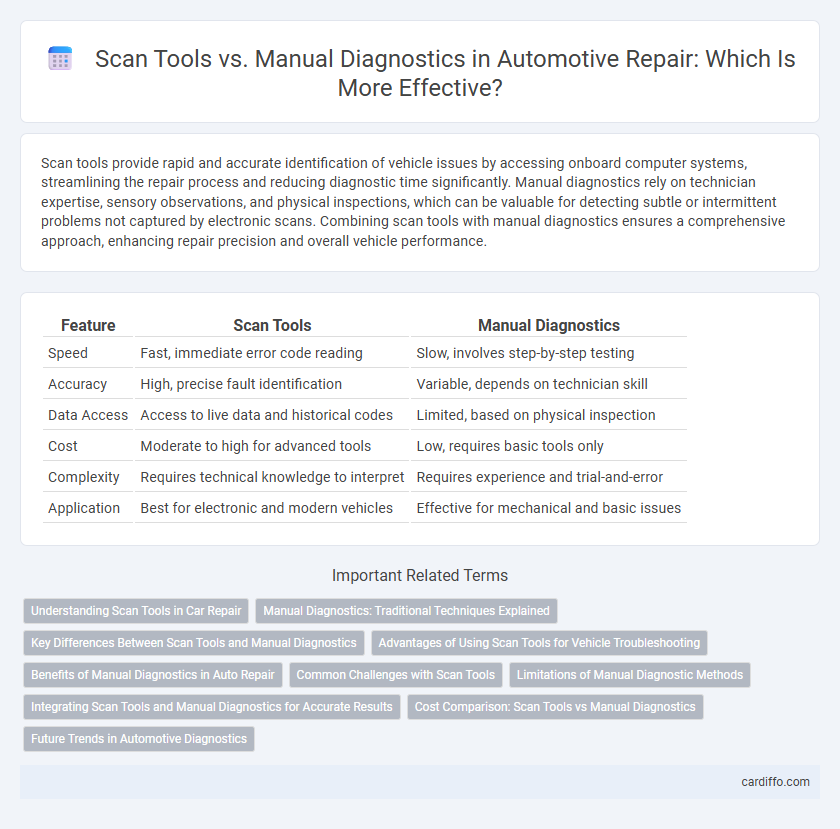Scan tools provide rapid and accurate identification of vehicle issues by accessing onboard computer systems, streamlining the repair process and reducing diagnostic time significantly. Manual diagnostics rely on technician expertise, sensory observations, and physical inspections, which can be valuable for detecting subtle or intermittent problems not captured by electronic scans. Combining scan tools with manual diagnostics ensures a comprehensive approach, enhancing repair precision and overall vehicle performance.
Table of Comparison
| Feature | Scan Tools | Manual Diagnostics |
|---|---|---|
| Speed | Fast, immediate error code reading | Slow, involves step-by-step testing |
| Accuracy | High, precise fault identification | Variable, depends on technician skill |
| Data Access | Access to live data and historical codes | Limited, based on physical inspection |
| Cost | Moderate to high for advanced tools | Low, requires basic tools only |
| Complexity | Requires technical knowledge to interpret | Requires experience and trial-and-error |
| Application | Best for electronic and modern vehicles | Effective for mechanical and basic issues |
Understanding Scan Tools in Car Repair
Scan tools revolutionize car repair by quickly accessing a vehicle's onboard diagnostic system to identify error codes and system malfunctions accurately. These devices provide detailed data on engine performance, transmission issues, and sensor statuses, enabling precise troubleshooting and reducing diagnostic time. Manual diagnostics rely heavily on technician experience and visual inspections, making scan tools essential for efficient, accurate repair processes in modern vehicles.
Manual Diagnostics: Traditional Techniques Explained
Manual diagnostics rely on technicians' expertise to identify vehicle issues through physical inspection, sounds, vibrations, and test drives without solely depending on scan tools. These traditional techniques include checking fluid levels, visual inspection of engine components, and using handheld devices like multimeters to measure electrical signals. Skilled technicians interpret symptoms and patterns that scan tools may not detect, ensuring a comprehensive understanding of complex mechanical problems.
Key Differences Between Scan Tools and Manual Diagnostics
Scan tools provide real-time data through onboard computer systems, enabling faster identification of error codes and system malfunctions. Manual diagnostics rely on technician expertise, physical inspections, and symptom analysis to uncover underlying mechanical or electrical issues. While scan tools enhance efficiency with automated data retrieval, manual diagnostics offer in-depth evaluation where complex or non-electronic problems exist.
Advantages of Using Scan Tools for Vehicle Troubleshooting
Scan tools provide precise and real-time diagnostic data by reading fault codes from a vehicle's onboard computer system, enabling faster identification of issues compared to manual methods. They offer comprehensive insights into engine performance, sensor statuses, and system malfunctions, reducing guesswork and improving repair accuracy. Utilizing scan tools increases efficiency by streamlining the troubleshooting process, minimizing diagnostic time, and ultimately lowering labor costs.
Benefits of Manual Diagnostics in Auto Repair
Manual diagnostics in auto repair offer detailed, hands-on assessment that scan tools may overlook, allowing technicians to detect subtle mechanical and electrical issues through tactile and auditory cues. This method enhances repair accuracy by leveraging expert intuition and experience, particularly in complex cases where digital data might be incomplete or ambiguous. Manual diagnostics also reduce reliance on software updates and compatibility constraints, making it a versatile approach across various vehicle makes and models.
Common Challenges with Scan Tools
Scan tools often face limitations in accurately detecting intermittent faults, sensor failures, or software glitches due to reliance on predefined error codes and live data streams. Manual diagnostics require interpreting raw data and physical inspection, which helps identify issues that scan tools may overlook, such as wiring problems or unusual noises. Technicians must balance scan tool data with hands-on analysis to effectively troubleshoot complex automotive problems.
Limitations of Manual Diagnostic Methods
Manual diagnostics often rely heavily on technician experience and visible symptoms, leading to potential misinterpretation and missed underlying issues. The inability to access real-time data and comprehensive system codes restricts the accuracy and efficiency of fault detection. Scan tools provide detailed, standardized information from vehicle ECUs, surpassing the subjective nature and limited scope of manual inspections.
Integrating Scan Tools and Manual Diagnostics for Accurate Results
Integrating scan tools and manual diagnostics enhances repair accuracy by combining automated data analysis with hands-on inspection to detect complex vehicle issues. Scan tools provide real-time data and error codes from the vehicle's onboard diagnostics, while manual diagnostics allow technicians to interpret symptoms and physical signs beyond digital readouts. This synergy reduces diagnostic errors, speeds up troubleshooting, and ensures comprehensive repair solutions.
Cost Comparison: Scan Tools vs Manual Diagnostics
Scan tools offer a cost-effective solution by reducing labor hours and increasing diagnostic accuracy, typically costing between $200 and $5,000 depending on the model and features. Manual diagnostics rely heavily on technician expertise and time, often resulting in higher labor expenses and potential for human error, which can drive up overall repair costs. Investing in advanced scan tools minimizes repeat diagnostics and accelerates repair times, providing long-term savings compared to traditional manual methods.
Future Trends in Automotive Diagnostics
Scan tools are rapidly evolving with integration of AI and machine learning algorithms, enabling predictive diagnostics and real-time data analysis for complex vehicle systems. Manual diagnostics remain essential for nuanced fault detection and verification, especially in cases where sensor data may be inconclusive or unavailable. Future trends emphasize hybrid diagnostic approaches combining advanced scan tools with expert manual inspection to enhance accuracy and reduce repair times in automotive maintenance.
Scan tools vs Manual diagnostics Infographic

 cardiffo.com
cardiffo.com